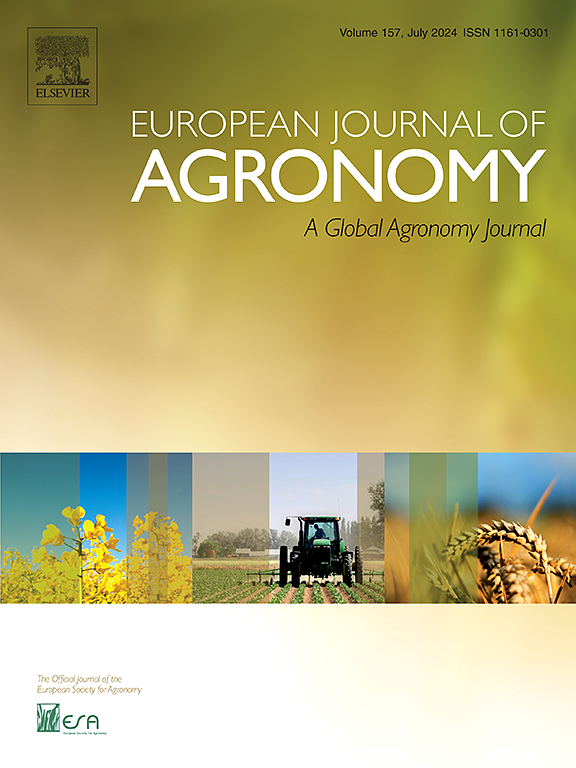预测气候变化对东非马铃薯产量的影响
IF 5.5
1区 农林科学
Q1 AGRONOMY
引用次数: 0
摘要
本研究探讨了气候变化对东非马铃薯生产的影响。为了评估这些影响,我们利用WOFOST作物模型模拟了两种气候情景(SSP3.7和SSP5-8.5)下的当前(1981-2010)、近未来(2036-2065)和远未来(2066-2100)的潜在产量(Yp)和限水产量(Yw),并使用了ISIMIP项目的五元环流模式(GCM)集合。模拟结果一致显示,在未来的所有时期,Yp和Yw都大幅下降。具体而言,在长雨季(LRS),如果没有二氧化碳施肥,预计潜在产量将下降37-71 %,限水产量将下降25-57 %,而在短雨季(SRS),潜在产量的下降幅度为39-75 %,限水产量的下降幅度为32-60 %,具体变化取决于海拔和情景。即使考虑到升高的CO2水平,在LRS中Yp仍然下降23-57 %,Yw下降20-49 %,在SRS中下降21-60 %和20-48 %。此外,预计马铃薯种植土地适宜性的下降是明显的,到2050年将有82% %的土地不适合种植,到2080年将有89% %的土地不适合种植,特别是在低海拔地区。虽然二氧化碳浓度升高和降雨量略有增加可能带来一些有限的好处,但这些都不足以抵消温度上升的有害影响,温度上升仍然是马铃薯产量的主要制约因素。因此,这些发现表明,由于气候变化,到本世纪末,传统的马铃薯种植可能变得不可持续。该研究强调,迫切需要有效的适应战略,包括实施气候智能型农业(CSA)实践,以维持中期马铃薯生产。它进一步强调了在未来气候条件下可能不适合种植马铃薯的地区过渡到替代作物的潜在必要性。基于相对高分辨率的CMIP6数据和WOFOST作物模型,本研究为制定适应战略提供了可操作的指导,强调了将减缓和适应气候变化纳入农业规划以确保东非粮食安全和保护农村生计的重要性。本文章由计算机程序翻译,如有差异,请以英文原文为准。
Projected climate change impacts on Potato yield in East Africa
This study examines the impacts of climate change on potato production in East Africa. To assess these impacts, we utilised the WOFOST crop model to simulate both potential yield (Yp) and water-limited yield (Yw) for the present-day (1981–2010), near-future (2036–2065), and far-future (2066–2100) under two climate scenarios (SSP3.7 and SSP5–8.5), using a five-member General Circulation Model (GCM) ensemble from the ISIMIP project. The simulations consistently reveal a substantial decline in both Yp and Yw across all future periods. Specifically, without CO2 fertilisation, potential yields are projected to decrease by 37–71 %, and water-limited yields by 25–57 % during the Long Rain season (LRS), while during the Short Rain Season(SRS), these declines range from 39–75 % for potential yields and 32–60 % for water-limited yields, with variations depending on elevation and scenario. Even when accounting for elevated CO2 levels, Yp still decline by 23–57 %, and Yw by 20–49 % in LRS, and by 21–60 % and 20–48 % in SRS. Furthermore, the projected decline in land suitability for potato cultivation is stark, with 82 % of land becoming unsuitable by 2050 and 89 % by 2080, particularly during the LRS. Although elevated CO2 and slight increases in rainfall may provide some limited benefits, these are insufficient to counteract the detrimental effects of rising temperatures, which remain the primary constraint on potato productivity. Consequently, these findings suggest that conventional potato cultivation may become unsustainable by the end of the century due to climate change. The study underscores the pressing need for effective adaptation strategies, including the implementation of Climate Smart Agriculture (CSA) practices, to sustain potato production in the medium term. It further highlights the potential necessity of transitioning to alternative crops in regions that may become unsuitable for potatoes under future climate conditions. By offering region-specific insights based on relatively high-resolution CMIP6 data and the WOFOST crop model, this research provides actionable guidance for the development of adaptation strategies, reinforcing the importance of integrating climate change mitigation and adaptation into agricultural planning to ensure food security and protect rural livelihoods in East Africa.
求助全文
通过发布文献求助,成功后即可免费获取论文全文。
去求助
来源期刊

European Journal of Agronomy
农林科学-农艺学
CiteScore
8.30
自引率
7.70%
发文量
187
审稿时长
4.5 months
期刊介绍:
The European Journal of Agronomy, the official journal of the European Society for Agronomy, publishes original research papers reporting experimental and theoretical contributions to field-based agronomy and crop science. The journal will consider research at the field level for agricultural, horticultural and tree crops, that uses comprehensive and explanatory approaches. The EJA covers the following topics:
crop physiology
crop production and management including irrigation, fertilization and soil management
agroclimatology and modelling
plant-soil relationships
crop quality and post-harvest physiology
farming and cropping systems
agroecosystems and the environment
crop-weed interactions and management
organic farming
horticultural crops
papers from the European Society for Agronomy bi-annual meetings
In determining the suitability of submitted articles for publication, particular scrutiny is placed on the degree of novelty and significance of the research and the extent to which it adds to existing knowledge in agronomy.
 求助内容:
求助内容: 应助结果提醒方式:
应助结果提醒方式:


